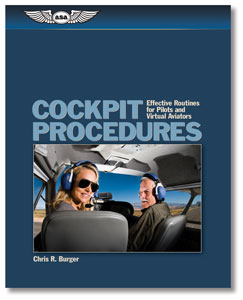"How-to" guide for what you should be doing in the cockpit during each phase of flight!
Written by an experienced instructor and pilot examiner, Cockpit Procedures provides a solid understanding of the underlying principles for, and detailed descriptions of the checklists and routines used in many flight schools. Readers will find it contains a practical definition of airmanship, and covers what good habits to develop, effective workload management, and even what you should have in your flight bag. Cockpit Procedures is about cockpit actions and thinking, giving readers the rationale behind common procedures that are standard practice in the training environment and in the airlines.
Both airplanes and helicopters are covered, delivering the essential aspects of effective training — technical knowledge, practical application and context learning. Cockpit Procedures targets the pilot just beginning his/her career, yet many of the philosophies and practical techniques taught here are so fundamental and powerful they will carry a pilot right through to retirement. While encouraging structure and discipline regarding procedures, the author does not merely check off lists of dry facts — Cockpit Procedures is also fun to read and Chris Burger keeps his readers focused with lively description and his knack for getting down to essentials in such a way that they stay with you.
Cockpit Procedures sets out to explain the nitty gritty of operating aircraft, both airplanes and helicopters. The book is being used for training brand new student pilots, but it is also intended for more advanced pilots trying to improve their technique. Any pilot undergoing advanced training will benefit greatly from the step-by-step coverage of routine and abnormal flying provided in this book. Would-be commercial pilots will benefit from learning perspectives on cockpit operations that will stand them in good stead in their careers, whether in the airlines or in general aviation.
The book contains:
- An overview, describing how to use the book and what its aim is.
- The use of checklists, describing action lists, flows and true checklists.
- A step-by-step description of a normal flight, from the moment you arrive at the aircraft to the moment you leave the airport.
- Sections on abnormal and emergency procedures, outlining priorities and thinking, as well as some specific procedures applicable to most airplanes.
- A section on helicopter operations, indicating how the priorities and procedures are fundamentally the same, and providing pointers on how to adapt existing airplane procedures to helicopters.
- A section on airmanship, including a breakdown of the required components and some practical tips. There are also sections on workload management and the practicalities of packing your flight bag.
- A description of aircraft handbooks, describing the standardized format, the meaning of certain terms and the thinking behind the structure of all modern general aviation aircraft handbooks.
- A set of sample checklists for light airplanes.
- A section on Morse code, including a decoding tree. This section will help you greatly if you have to identify radio beacons aurally.
Flight schools can use the book to illuminate their flying school SOPs, which encourages standardization between students and instructors. Once a student has gained a solid understanding of SOPs, the school can publish its own preferences in a handy reference document that students will easily understand.
Virtual aviators have an amazing level of realism at their fingertips, in the form of interface devices and software that faithfully mimic the real aircraft. Until now, there has been no way to obtain a blow-by-blow description of happenings in the cockpit without taking instruction with a qualified pilot. This book solves this problem for virtual aviators by describing the actions required for each phase of flight in great detail.
The emphasis is practical. As an example, try these sections in the chapter on airmanship:
- A list of good habits that you should cultivate.
- A list of things to have in your flight bag.
- How to correctly aim an aircraft at a point on the horizon.
- How to manage risky events, such as changing fuel tanks.
- How to manage workload, by redistributing the actions performed in the flight.
- How to maintain a healthy balance between being careful and being confident.
Chris R. Burger is an instructor and pilot examiner, flies both airplanes and helicopters, was previously an Air Traffic Controller, and runs a flying school in South Africa. As a flight instructor whose academic background includes aviation psychology expertise, Chris works to promote a culture of safety and teach pilots how to stay out of trouble in the skies — a task well-served by more than 2,500 hours of instructor experience in over 80 different aircraft models.
Includes illustrations, glossary, and helpful appendices. Softcover, 7-1/4" x 9", 144 pages.
[ASA-COCKPIT-PRO] 